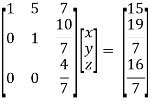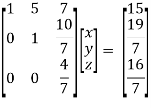Unit-3
Matrices
Question-1: check whether the following matrix A is symmetric or not?
A = 
Sol. As we know that if the transpose of the given matrix is same as the matrix itself then the matrix is called symmetric matrix.
So that, first we will find its transpose,
Transpose of matrix A ,

Here,
A = 
So that, the matrix A is symmetric.
Question-2: Let us test whether the given matrices are symmetric or not i.e., we check for,
A = 
(1) A = 

 Now
Now
 =
=
 A =
A = 
Hence the given matric symmetric
Question-3: prove Q=  is an orthogonal matrix
is an orthogonal matrix
Solution: Given Q = 
So, QT =  …..(1)
…..(1)
Now, we have to prove QT = Q-1
Now we find Q-1
Q-1 = 
Q-1 = 
Q-1 = 
Q-1 =  … (2)
… (2)
Now, compare (1) and (2) we get QT = Q-1
Therefore, Q is an orthogonal matrix.
Question-4: Express the matrix A as sum of hermitian and skew-hermitian matrix where 
Let A =
Therefore  and
and 
Let 
Again 
Hence P is a hermitian matrix.
Let 
Again 
Hence Q is a skew- hermitian matrix.
We Check
P +Q=
Hence proved.
Question-5: Find the rank of a matrix M by echelon form.
M = 
Sol. First we will convert the matrix M into echelon form,
M = 
Apply,  , we get
, we get
M = 
Apply  , we get
, we get
M = 
Apply 
M = 
We can see that, in this echelon form of matrix, the number of non – zero rows is 3.
So that the rank of matrix X will be 3.
Question-6: Find the rank of a matrix A by echelon form.
A = 
Sol. Convert the matrix A into echelon form,
A = 
Apply 
A = 
Apply  , we get
, we get
A = 
Apply  , we get
, we get
A = 
Apply  ,
,
A = 
Apply  ,
,
A = 
Therefore the rank of the matrix will be 2.
Question-7: Find the rank of the following matrices by echelon form?
Let A = 
Applying 
A 
Applying 
A 
Applying 
A 
Applying 
A 
It is clear that minor of order 3 vanishes but minor of order 2 exists as 
Hence rank of a given matrix A is 2 denoted by 
Question-8: reduce the matrix A to its normal form and find rank as well.

Sol. We have,

We will apply elementary row operation,



We get,

Now apply column transformation,



We get,

Apply
 , we get,
, we get,

Apply  and
and 

Apply 

Apply  and
and 

Apply  and
and 

As we can see this is required normal form of matrix A.
Therefore the rank of matrix A is 3.
Question-9: Find the rank of the following matrices by reducing it to the normal form.

Solution:

Apply C14















Question-10: Check the consistency and find the values of x , y and z of the following system of linear equations.
2x + 3y + 4z = 11
X + 5y + 7z = 15
3x + 11y + 13z = 25
Sol. Re-write the system of equations in augmented matrix form.
C = [A,B]
That will be,

Apply 

Now apply ,
We get,
 ~
~ ~
~
Here rank of A = 3
And rank of C = 3, so that the system of equations is consistent,
So that we can can solve the equations as below,

That gives,
x + 5y + 7z = 15 ……………..(1)
y + 10z/7 = 19/7 ………………(2)
4z/7 = 16/7 ………………….(3)
From eq. (3)
z = 4,
From 2,

From eq.(1), we get
x + 5(-3) + 7(4) = 15
That gives,
x = 2
Therefore the values of x , y , z are 2 , -3 , 4 respectively.
Question-11: Are the vectors  ,
,  ,
,  linearly dependent. If so, express x1 as a linear combination of the others.
linearly dependent. If so, express x1 as a linear combination of the others.
Solution:
Consider a vector equation,

i.e. 




Which can be written in matrix form as,







Here  & no. Of unknown 3. Hence the system has infinite solutions. Now rewrite the questions as,
& no. Of unknown 3. Hence the system has infinite solutions. Now rewrite the questions as,


Put 
 and
and




Thus 
i.e. 
i.e. 


Since F11 k2, k3 not all zero. Hence  are linearly dependent.
are linearly dependent.
Question-12: Find the characteristic equation of the matrix A =  andVerify cayley-Hamlton theorem.
andVerify cayley-Hamlton theorem.
Sol. Characteristic equation of the matrix, we can be find as follows-

Which is,
( 2 - , which gives
, which gives

According to cayley-Hamilton theorem,
 …………(1)
…………(1)
Now we will verify equation (1),


Put the required values in equation (1) , we get




Hence the cayley-Hamilton theorem is verified.
Question-13: Find the characteristic equation of the the matrix A and verify Cayley-Hamilton theorem as well.
A = 
Sol. Characteristic equation will be-
 = 0
= 0
( 7 -
(7-
(7-
Which gives,

Or

According to cayley-Hamilton theorem,
 …………………….(1)
…………………….(1)
In order to verify cayley-Hamilton theorem , we will find the values of 
So that,

Now



Put these values in equation(1), we get

 = 0
= 0


Hence the cayley-hamilton theorem is verified.
Question-14: Verify the Cayley-Hamilton theorem and find the inverse.
 ?
?
Sol. Let A =
The characteristics equation of A is 


Or 
Or 
Or 
By Cayley-Hamilton theorem 
L.H.S: 


=  =0=R.H.S
=0=R.H.S
Multiply both side by  on
on 

Or 
Or  [
[
Or 
Question-15: Determine the eigen values of eigen vector of the matrix.

Solution:
Consider the characteristic equation as, 
i.e. 
i.e. 



i.e. 
Which is the required characteristic equation.


 are the required eigen values.
are the required eigen values.
Now consider the equation
 … (1)
… (1)
Case I:
If  Equation (1)becomes
Equation (1)becomes

R1 + R2







Thus 
 independent variable.
independent variable.
Now rewrite equation as,


Put x3 = t
 &
&



Thus  .
.
Is the eigen vector corresponding to  .
.
Case II:
If  equation (1) becomes,
equation (1) becomes,









Here 
 independent variables
independent variables
Now rewrite the equations as,


Put 
 &
&



 .
.
Is the eigen vector corresponding to  .
.
Case III:
If  equation (1) becomes,
equation (1) becomes,











Here rank of 
 independent variable.
independent variable.
Now rewrite the equations as,


Put 

Thus  .
.
Is the eigen vector for  .
.
Unit-3
Matrices
Question-1: check whether the following matrix A is symmetric or not?
A = 
Sol. As we know that if the transpose of the given matrix is same as the matrix itself then the matrix is called symmetric matrix.
So that, first we will find its transpose,
Transpose of matrix A ,

Here,
A = 
So that, the matrix A is symmetric.
Question-2: Let us test whether the given matrices are symmetric or not i.e., we check for,
A = 
(1) A = 

 Now
Now
 =
=
 A =
A = 
Hence the given matric symmetric
Question-3: prove Q=  is an orthogonal matrix
is an orthogonal matrix
Solution: Given Q = 
So, QT =  …..(1)
…..(1)
Now, we have to prove QT = Q-1
Now we find Q-1
Q-1 = 
Q-1 = 
Q-1 = 
Q-1 =  … (2)
… (2)
Now, compare (1) and (2) we get QT = Q-1
Therefore, Q is an orthogonal matrix.
Question-4: Express the matrix A as sum of hermitian and skew-hermitian matrix where 
Let A =
Therefore  and
and 
Let 
Again 
Hence P is a hermitian matrix.
Let 
Again 
Hence Q is a skew- hermitian matrix.
We Check
P +Q=
Hence proved.
Question-5: Find the rank of a matrix M by echelon form.
M = 
Sol. First we will convert the matrix M into echelon form,
M = 
Apply,  , we get
, we get
M = 
Apply  , we get
, we get
M = 
Apply 
M = 
We can see that, in this echelon form of matrix, the number of non – zero rows is 3.
So that the rank of matrix X will be 3.
Question-6: Find the rank of a matrix A by echelon form.
A = 
Sol. Convert the matrix A into echelon form,
A = 
Apply 
A = 
Apply  , we get
, we get
A = 
Apply  , we get
, we get
A = 
Apply  ,
,
A = 
Apply  ,
,
A = 
Therefore the rank of the matrix will be 2.
Question-7: Find the rank of the following matrices by echelon form?
Let A = 
Applying 
A 
Applying 
A 
Applying 
A 
Applying 
A 
It is clear that minor of order 3 vanishes but minor of order 2 exists as 
Hence rank of a given matrix A is 2 denoted by 
Question-8: reduce the matrix A to its normal form and find rank as well.

Sol. We have,

We will apply elementary row operation,



We get,

Now apply column transformation,



We get,

Apply
 , we get,
, we get,

Apply  and
and 

Apply 

Apply  and
and 

Apply  and
and 

As we can see this is required normal form of matrix A.
Therefore the rank of matrix A is 3.
Question-9: Find the rank of the following matrices by reducing it to the normal form.

Solution:

Apply C14















Question-10: Check the consistency and find the values of x , y and z of the following system of linear equations.
2x + 3y + 4z = 11
X + 5y + 7z = 15
3x + 11y + 13z = 25
Sol. Re-write the system of equations in augmented matrix form.
C = [A,B]
That will be,

Apply 

Now apply ,
We get,
 ~
~ ~
~
Here rank of A = 3
And rank of C = 3, so that the system of equations is consistent,
So that we can can solve the equations as below,

That gives,
x + 5y + 7z = 15 ……………..(1)
y + 10z/7 = 19/7 ………………(2)
4z/7 = 16/7 ………………….(3)
From eq. (3)
z = 4,
From 2,

From eq.(1), we get
x + 5(-3) + 7(4) = 15
That gives,
x = 2
Therefore the values of x , y , z are 2 , -3 , 4 respectively.
Question-11: Are the vectors  ,
,  ,
,  linearly dependent. If so, express x1 as a linear combination of the others.
linearly dependent. If so, express x1 as a linear combination of the others.
Solution:
Consider a vector equation,

i.e. 




Which can be written in matrix form as,







Here  & no. Of unknown 3. Hence the system has infinite solutions. Now rewrite the questions as,
& no. Of unknown 3. Hence the system has infinite solutions. Now rewrite the questions as,


Put 
 and
and




Thus 
i.e. 
i.e. 


Since F11 k2, k3 not all zero. Hence  are linearly dependent.
are linearly dependent.
Question-12: Find the characteristic equation of the matrix A =  andVerify cayley-Hamlton theorem.
andVerify cayley-Hamlton theorem.
Sol. Characteristic equation of the matrix, we can be find as follows-

Which is,
( 2 - , which gives
, which gives

According to cayley-Hamilton theorem,
 …………(1)
…………(1)
Now we will verify equation (1),


Put the required values in equation (1) , we get




Hence the cayley-Hamilton theorem is verified.
Question-13: Find the characteristic equation of the the matrix A and verify Cayley-Hamilton theorem as well.
A = 
Sol. Characteristic equation will be-
 = 0
= 0
( 7 -
(7-
(7-
Which gives,

Or

According to cayley-Hamilton theorem,
 …………………….(1)
…………………….(1)
In order to verify cayley-Hamilton theorem , we will find the values of 
So that,

Now



Put these values in equation(1), we get

 = 0
= 0


Hence the cayley-hamilton theorem is verified.
Question-14: Verify the Cayley-Hamilton theorem and find the inverse.
 ?
?
Sol. Let A =
The characteristics equation of A is 


Or 
Or 
Or 
By Cayley-Hamilton theorem 
L.H.S: 


=  =0=R.H.S
=0=R.H.S
Multiply both side by  on
on 

Or 
Or  [
[
Or 
Question-15: Determine the eigen values of eigen vector of the matrix.

Solution:
Consider the characteristic equation as, 
i.e. 
i.e. 



i.e. 
Which is the required characteristic equation.


 are the required eigen values.
are the required eigen values.
Now consider the equation
 … (1)
… (1)
Case I:
If  Equation (1)becomes
Equation (1)becomes

R1 + R2







Thus 
 independent variable.
independent variable.
Now rewrite equation as,


Put x3 = t
 &
&



Thus  .
.
Is the eigen vector corresponding to  .
.
Case II:
If  equation (1) becomes,
equation (1) becomes,









Here 
 independent variables
independent variables
Now rewrite the equations as,


Put 
 &
&



 .
.
Is the eigen vector corresponding to  .
.
Case III:
If  equation (1) becomes,
equation (1) becomes,











Here rank of 
 independent variable.
independent variable.
Now rewrite the equations as,


Put 

Thus  .
.
Is the eigen vector for  .
.

